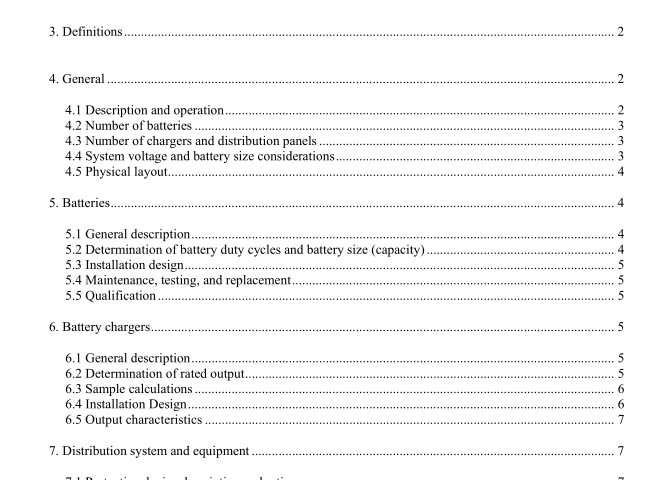IEEE 946-2004 pdf download.IEEE Recommended Practice for the Design of DC Auxiliary Power Systems for Generating Stations
Definitions For the purposes of this recommended practice, the following terms and definitions apply. The Authoritative Dictionary of IEEE Standards [B2] 3 , should be referenced for terms not defined in this clause.
3.1 battery capacity: The amp-hours available in an installed battery as measured by test. This is measured, normally after an equalize charge, by a performance or modified performance test. The battery capacity may be larger or smaller than the rated capacity and is expressed as a per cent of rated capacity for a given duration. For lead acid batteries, this is due to degradation of the grid, connections, welds, pellet interface to the grid, crystal surface contact interface of the lead oxides, wet surface interface between the lead oxide and the electrolyte, electrolyte specific gravity, and transport resistance of the hydrogen and oxygen between the positive and negative plates. Since the factors which affect battery performance are varied, the measured battery capacity at a long duration may differ from the measured capacity at a short duration.
3.2 battery rated capacity: The rated amp-hours available in a battery at 100% charge. This is established via “S” or fan curves by a manufacturer’s test of a limited sample of cells using the interconnecting hardware supplied with the standard installation. The rated amp-hours may differ as a function of the discharge duration, long duration discharges typically utilizes the available material more effectively.
NOTE—See IEEE Std 485 for an example of the manufacturer’s sizing curves.
3.3 battery state of charge: A factor between 0 and 100. It establishes the available amp-hours by multiplying the state of charge times the battery capacity times the battery rated capacity for a specified discharge duration.
The battery state of charge reflects the conversion or restoration of lead sulfate to lead oxide after a discharge. General Description and operation All power generating stations require dc auxiliary power systems to operate those dc components that must be available should a loss of ac power occur. Some examples of such components are auxiliary motors, circuit breakers, relays, solenoids, and inverters.
The dc source(s) may be one common battery for both power and control or two separate batteries; one for power and another for control and instrumentation. Separate batteries are recommended for special services such as for engine (cranking) starting.
In normal operation, the battery and charger(s) are both connected to the dc distribution bus and, therefore, operate as parallel sources to supply the connected loads.
The charger, in addition to charging the battery, carries the normal continuous load. Chargers are typically provided with a current limiting circuit for overload protection. If overloaded, the charger output voltage will drop, causing all loads in excess of the charger rating to be supplied by the battery. In the event of:
a) a failure of the ac power supply to the charger(s) or
b) a charger failure (or the removal of the charger from service), the battery must supply all of the power required by the loads for some designed period of time. Specific design guidance for dc systems for nuclear generating stations are discussed fully in numerous design standards found in Annex A.
4.2 Number of batteries
As a minimum, one battery should be provided for each unit. If the auxiliary loads of one unit are divided into two or more independent systems, then each independent system should be provided with a separate battery. If the maximum dc power requirements exceed the capacity of one battery, then the development of two independent systems should be considered. Cross-ties from other batteries may be provided, where appropriate (see 7.7).
For Class 1 E nuclear applications, as a minimum, a separate battery shall be provided for each Engineered Safety Feature (ESF) Division in each unit in order to provide the required independence between redundant Class 1E power systems. For increased operating flexibility in designs where the reactor protection system channels are dependent on dc, the number of safety-related batteries provided on each unit should equal the number of independent and redundant reactor protection system (instrumentation and control) channels. For example, in a unit with four reactor protection channels, four batteries should be provided.
The rated capacity of each battery should be determined as described in 5.2 of this guide.
4.3 Number of chargers and distribution panels
As a minimum, one battery charger and main distribution panel should be provided for each battery. Additional (spare or standby) chargers should be considered for increased operating flexibility and plant availability (see Clause 8.)IEEE 946 pdf download.IEEE 946-2004 pdf download
IEEE 946-2004 pdf download

Leave a Reply